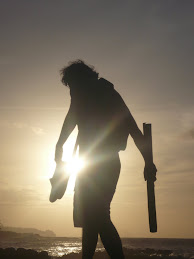Although this community is dealing with the implications of the impending extinction of their native language, Araki Island appears to be doing many things right from a food security & community resilience standpoint. While many people have moved to the nearest urban center of Luganville in search of work, much of the villages’ food is still grown on the island. In addition to white rice, canned fish appears to be a staple here - perhaps as a response to the seasonal fishing that is available on Araki.
While an integrated coconut/cacao understory cash crop plantation on the island has the potential to generate more local income through value-added processes (such as pressing their own coconut oil and creating artisan products such as soap & chocolate), care must be taken that any development projects geared towards increasing economic gain do not compromise food security.
This is one illustration of the opposing tensions of traditional vs. modern culture discussed in the previous section; it is unclear if people have left the island because of a lack of food security, or in pursuit of the perceived affluence offered by prospects of life in the city.
- excerpt from 'Kaikai fo Laef Project Report 2012' -
A recent lecture by Anthropologist & Enthnobotanist Wade Davis at The University of Hawaii @ Manoa has me reflecting back to our time spent on Araki Island in Vanuatu.
Photo: Field notes, data source: 'Sea level change', by National Research Council (U.S.). Geophysics Study Committee. National Academies, 1990.Araki Island is noteworthy for its 3 distinct terraces rising from the sea, each level remnants of a coral reef bed thrust upwards in 3 distinct geographical ages.
We arrive by banana boat about an hour or so before nightfall, cautiously timing our leap from bobbing boat to rocky ledge that would be impossible in rough seas. Then, in what has to be the quickest tour of the island ever given, we are whisked away to explore the slash-and-burn sustenance gardens perched on the second terrace above the village while there was still light.
We march uphill through the densely forested slopes which smell heavily of earthy fungi, to emerge blinking into a freshly burnt garden plot, its scorched earth jarring to all our senses. Mountain taro (cocoyam), cassava, yams, varieties of Island cabbage (Abelmoschus manihot), and sweet potatoes were planted throughout, while sapprophytic fungi quickly colonized the dead & dying trees within the newly cleared plot.
Photos: Freshly cleared garden plot on second terrace; Sapprophytic mushrooms colonizing dead wood; Newly planted cocoyams; newly planted cassava.
As the golden hour of sunset intensified, we decide to ascend to the upper terrace against all precautionary logic, risking being caught in the rapidly encroaching darkness of nightfall - but are told (with a sly wink) that the bioluminescent mushrooms will help light our way home if needed, and I am tempted to linger long enough to see what a forest full of glow-in-the-dark mushrooms looks like in the tropical night of a half moon.
Photos: Garden on Araki's upper terrace; Wild chicken trap made from vines; Bioluminescent mushroom.Later that evening, while waiting for the community to gather for a gardening Q&A session in the longhouse, we learn that the Araki language is only spoken by the Chief, his 2 brothers, and their sister. In a village of only 200 people, the children attend school until the 6th grade on Araki, then commute to nearby Santo Island for their higher grade levels, until finally the majority of Araki youth head to the urban center of Luganville in search of more opportunity.
The leadership is strong here, the vibrant sense of community palpable in the longhouse that night, and the people of Araki a proud, resourceful & resilient bunch. Yet despite this their living language is perched precariously on the edge of extinction, primarily as a result of the relentlessly irrestible pull of modern culture: What good to the market is a dying language spoken on a tiny island by less than 200 people?
To help answer this question I offer three quotes from Wade Davis:
"Together the myriad of cultures makes up an intellectual and spritual web of life that envelops the planet and is every bit as important to the well being of the planet as is the biological web of life that we know as the 'biosphere'. You might think of this social web of life as an "ethnosphere", a term best defined as the sum total of all thoughts and intuitions, myths and beliefs, ideas and inspirations brought into being by the human imagination since the dawn of consciousness"
"What could be more lonley than to be enveloped in silence, to be the last of your people to speak your native tongue, to have no way to pass on the wisdom of your ancestors or anticipate the promise of your descendants."
"Every language is an old-growth forest of the mind, a watershed of thought, an ecosystem of spiritual possibilities."
- Wade Davis, author of 'The Wayfinders: Why Ancient Wisdom Matters in the Modern World -
For further exploration of the enthosphere, see: http://www.ted.com/talks/wade_davis_on_endangered_cultures.html

